2. Said MA, Johnson HL, Nonyane BA, Deloria-Knoll M, O’Brien KL, Andreo F, et al. Estimating the burden of pneumococcal pneumonia among adults: a systematic review and meta-analysis of diagnostic techniques. PLoS One. 2013; 8(4):e60273. PMID:
23565216.
3. Hausdorff WP, Feikin DR, Klugman KP. Epidemiological differences among pneumococcal serotypes. Lancet Infect Dis. 2005; 5(2):83–93. PMID:
15680778.
4. Song JY, Nahm MH, Moseley MA. Clinical implications of pneumococcal serotypes: invasive disease potential, clinical presentations, and antibiotic resistance. J Korean Med Sci. 2013; 28(1):4–15. PMID:
23341706.
5. Ganaie F, Saad JS, McGee L, van Tonder AJ, Bentley SD, Lo SW, et al. A new pneumococcal capsule type, 10D, is the 100th serotype and has a large
cps fragment from an oral streptococcus. MBio. 2020; 11(3):e00937-20. PMID:
32430472.
6. Ministry of Health and Welfare. Seniors 65 Years of Age or Older Should Get the Pneumococcal Vaccine [Press Release]. Sejong, Korea: Ministry of Health and Welfare;2014.
8. Loo JD, Conklin L, Fleming-Dutra KE, Knoll MD, Park DE, Kirk J, et al. Systematic review of the indirect effect of pneumococcal conjugate vaccine dosing schedules on pneumococcal disease and colonization. Pediatr Infect Dis J. 2014; 33 Suppl 2:S161–S171. PMID:
24336058.
9. Shiri T, Datta S, Madan J, Tsertsvadze A, Royle P, Keeling MJ, et al. Indirect effects of childhood pneumococcal conjugate vaccination on invasive pneumococcal disease: a systematic review and meta-analysis. Lancet Glob Health. 2017; 5(1):e51–e59. PMID:
27955789.
10. Hanquet G, Krizova P, Dalby T, Ladhani SN, Nuorti JP, Danis K, et al. Serotype replacement after introduction of 10-valent and 13-valent pneumococcal conjugate vaccines in 10 countries, Europe. Emerg Infect Dis. 2022; 28(1):137–138. PMID:
34932457.
11. Weinberger DM, Malley R, Lipsitch M. Serotype replacement in disease after pneumococcal vaccination. Lancet. 2011; 378(9807):1962–1973. PMID:
21492929.
12. Pilishvili T, Lexau C, Farley MM, Hadler J, Harrison LH, Bennett NM, et al. Sustained reductions in invasive pneumococcal disease in the era of conjugate vaccine. J Infect Dis. 2010; 201(1):32–41. PMID:
19947881.
13. Balsells E, Guillot L, Nair H, Kyaw MH. Serotype distribution of Streptococcus pneumoniae causing invasive disease in children in the post-PCV era: a systematic review and meta-analysis. PLoS One. 2017; 12(5):e0177113. PMID:
28486544.
14. Ladhani SN, Collins S, Djennad A, Sheppard CL, Borrow R, Fry NK, et al. Rapid increase in non-vaccine serotypes causing invasive pneumococcal disease in England and Wales, 2000–17: a prospective national observational cohort study. Lancet Infect Dis. 2018; 18(4):441–451. PMID:
29395999.
15. Ben-Shimol S, Regev-Yochay G, Givon-Lavi N, van der Beek BA, Brosh-Nissimov T, Peretz A, et al. Dynamics of invasive pneumococcal disease in Israel in children and adults in the 13-valent pneumococcal conjugate vaccine (PCV13) era: a nationwide prospective surveillance. Clin Infect Dis. 2022; 74(9):1639–1649. PMID:
34293091.
16. Torres A, Menéndez R, España PP, Fernández-Villar JA, Marimón JM, Cilloniz C, et al. The evolution and distribution of pneumococcal serotypes in adults hospitalized with community-acquired pneumonia in Spain using a serotype-specific urinary antigen detection test: the CAPA study, 2011–2018. Clin Infect Dis. 2021; 73(6):1075–1085. PMID:
33851220.
17. Pick H, Daniel P, Rodrigo C, Bewick T, Ashton D, Lawrence H, et al. Pneumococcal serotype trends, surveillance and risk factors in UK adult pneumonia, 2013–18. Thorax. 2020; 75(1):38–49. PMID:
31594801.
18. Bahrs C, Kesselmeier M, Kolditz M, Ewig S, Rohde G, Barten-Neiner G, et al. A longitudinal analysis of pneumococcal vaccine serotypes in pneumonia patients in Germany. Eur Respir J. 2022; 59(2):2102432. PMID:
34824055.
19. Isturiz R, Grant L, Gray S, Alexander-Parrish R, Jiang Q, Jodar L, et al. Expanded analysis of 20 pneumococcal serotypes associated with radiographically confirmed community-acquired pneumonia in hospitalized US adults. Clin Infect Dis. 2021; 73(7):1216–1222. PMID:
33982098.
20. LeBlanc JJ, ElSherif M, Ye L, MacKinnon-Cameron D, Ambrose A, Hatchette TF, et al. Recalibrated estimates of non-bacteremic and bacteremic pneumococcal community acquired pneumonia in hospitalized Canadian adults from 2010 to 2017 with addition of an extended spectrum serotype-specific urine antigen detection assay. Vaccine. 2022; 40(18):2635–2646. PMID:
35315326.
21. Syrogiannopoulos GA, Katopodis GD, Grivea IN, Beratis NG. Antimicrobial use and serotype distribution of nasopharyngeal Streptococcus pneumoniae isolates recovered from Greek children younger than 2 years old. Clin Infect Dis. 2002; 35(10):1174–1182. PMID:
12410477.
22. Orsi A, Domnich A, Mosca S, Ogliastro M, Sticchi L, Prato R, et al. Prevalence of pneumococcal serotypes in community-acquired pneumonia among older adults in Italy: a multicenter cohort study. Microorganisms. 2022; 11(1):70. PMID:
36677362.
24. Jung YH, Choe YJ, Lee CY, Jung SO, Lee DH, Yoo JI. Impact of national pneumococcal vaccination program on invasive pneumococcal diseases in South Korea. Sci Rep. 2022; 12(1):15833. PMID:
36138123.
25. Vestrheim DF, Høiby EA, Aaberge IS, Caugant DA. Impact of a pneumococcal conjugate vaccination program on carriage among children in Norway. Clin Vaccine Immunol. 2010; 17(3):325–334. PMID:
20107006.
26. Heo JY, Seo YB, Choi WS, Lee J, Yoon JG, Lee SN, et al. Incidence and case fatality rates of community-acquired pneumonia and pneumococcal diseases among Korean adults: catchment population-based analysis. PLoS One. 2018; 13(3):e0194598. PMID:
29596444.
28. Heo JY, Seo YB, Jeong HW, Choi MJ, Min KH, Choi WS, et al. Epidemiology of community-acquired pneumonia in the era of extended serotype-covering multivalent pneumococcal conjugate vaccines. Vaccine. 2020; 38(49):7747–7755. PMID:
33164798.
29. Kim JH, Baik SH, Chun BC, Song JY, Bae IG, Kim HY, et al. Adult invasive pneumococcal disease in the Republic of Korea: Risk medical conditions and mortality stratified by age group. Int J Infect Dis. 2018; 74:136–144. PMID:
30055332.
30. Song JY, Nahm MH, Cheong HJ, Kim WJ. Impact of preceding flu-like illness on the serotype distribution of pneumococcal pneumonia. PLoS One. 2014; 9(4):e93477. PMID:
24691515.
31. Andrews NJ, Waight PA, Burbidge P, Pearce E, Roalfe L, Zancolli M, et al. Serotype-specific effectiveness and correlates of protection for the 13-valent pneumococcal conjugate vaccine: a postlicensure indirect cohort study. Lancet Infect Dis. 2014; 14(9):839–846. PMID:
25042756.
32. Jackson LA, Gurtman A, Rice K, Pauksens K, Greenberg RN, Jones TR, et al. Immunogenicity and safety of a 13-valent pneumococcal conjugate vaccine in adults 70 years of age and older previously vaccinated with 23-valent pneumococcal polysaccharide vaccine. Vaccine. 2013; 31(35):3585–3593. PMID:
23688527.
33. Poolman J, Kriz P, Feron C, Di-Paolo E, Henckaerts I, Miseur A, et al. Pneumococcal serotype 3 otitis media, limited effect of polysaccharide conjugate immunisation and strain characteristics. Vaccine. 2009; 27(24):3213–3222. PMID:
19446194.
34. Choi EH, Zhang F, Lu YJ, Malley R. Capsular polysaccharide (CPS) release by serotype 3 pneumococcal strains reduces the protective effect of anti-type 3 CPS antibodies. Clin Vaccine Immunol. 2015; 23(2):162–167. PMID:
26677201.
35. Platt HL, Greenberg D, Tapiero B, Clifford RA, Klein NP, Hurley DC, et al. A phase II trial of safety, tolerability and immunogenicity of V114, a 15-valent pneumococcal conjugate vaccine, compared with 13-valent pneumococcal conjugate vaccine in healthy infants. Pediatr Infect Dis J. 2020; 39(8):763–770. PMID:
32639460.
36. Simon JK, Staerke NB, Hemming-Harlo M, Layle S, Dagan R, Shekar T, et al. Lot-to-lot consistency, safety, tolerability, and immunogenicity of V114, a 15-valent pneumococcal conjugate vaccine, in healthy adults aged ≥50 years: a randomized phase 3 trial (PNEU-TRUE). Vaccine. 2022; 40(9):1342–1351. PMID:
35039194.
37. Varon E, Cohen R, Béchet S, Doit C, Levy C. Invasive disease potential of pneumococci before and after the 13-valent pneumococcal conjugate vaccine implementation in children. Vaccine. 2015; 33(46):6178–6185. PMID:
26476365.
38. Cohen R, Levy C, Ouldali N, Goldrey M, Béchet S, Bonacorsi S, et al. Invasive disease potential of pneumococcal serotypes in children after PCV13 implementation. Clin Infect Dis. 2021; 72(8):1453–1456. PMID:
32804200.
39. Welte T. Risk factors and severity scores in hospitalized patients with community-acquired pneumonia: prediction of severity and mortality. Eur J Clin Microbiol Infect Dis. 2012; 31(1):33–47. PMID:
21533875.
40. Nakashima K, Suzuki K, Aoshima M, Murabata M, Kondo K, Ohfuji S, et al. Effectiveness of the 23-valent pneumococcal polysaccharide vaccine against community-acquired pneumonia in older individuals after the introduction of childhood 13-valent pneumococcal conjugate vaccine: a multicenter hospital-based case-control study in Japan. Vaccine. 2022; 40(46):6589–6598. PMID:
36184405.
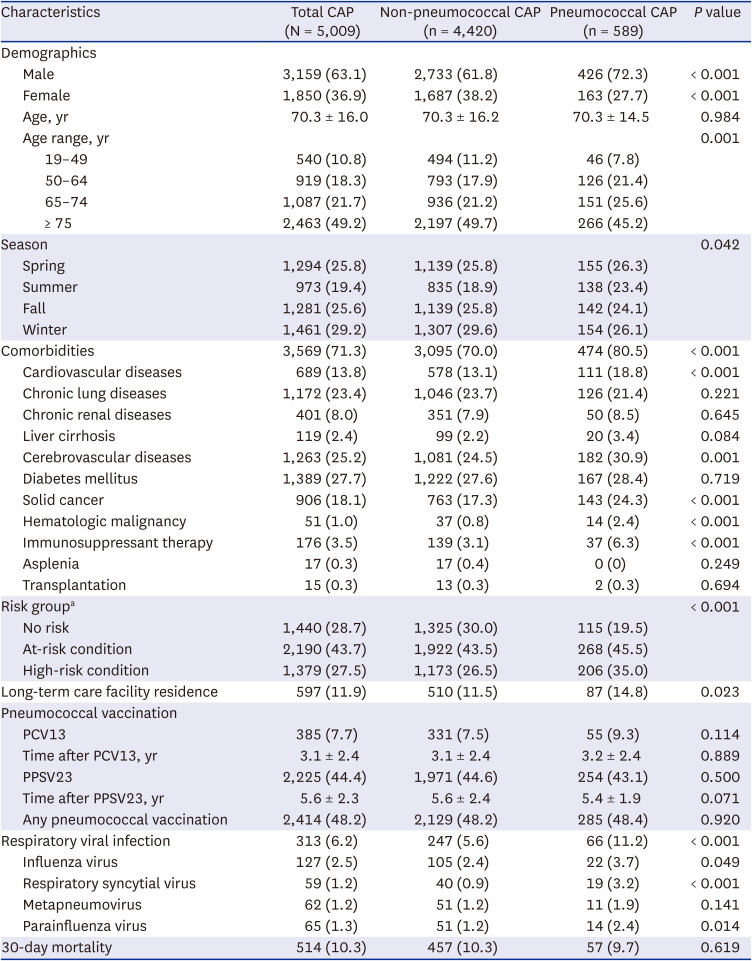
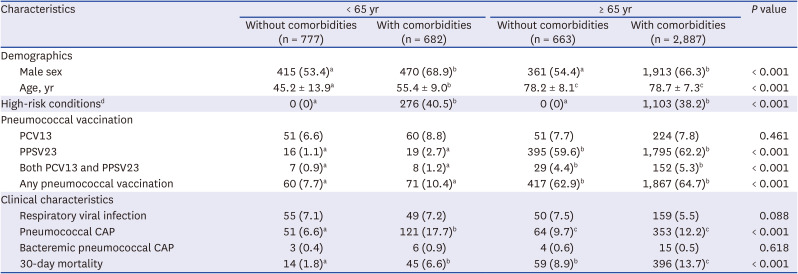
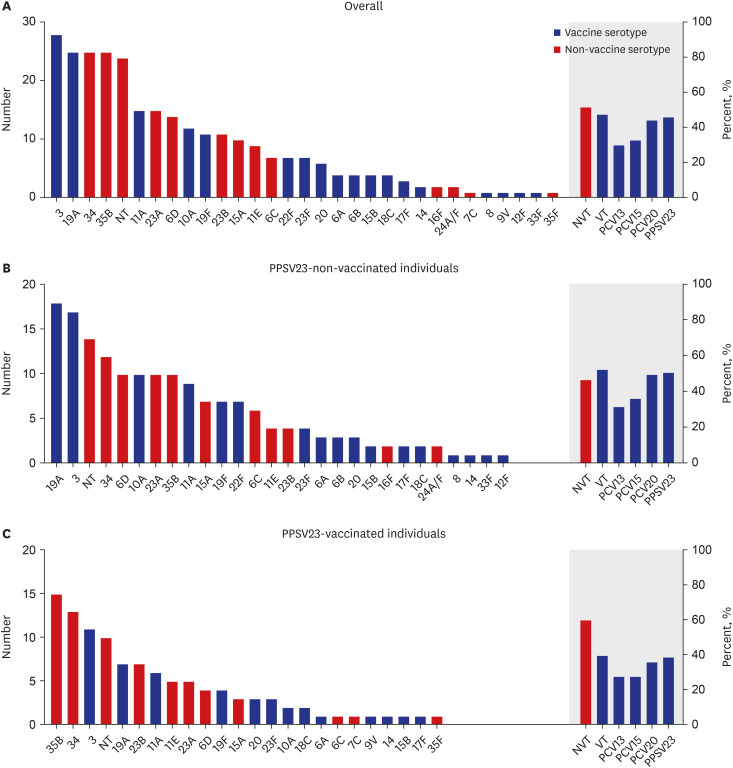
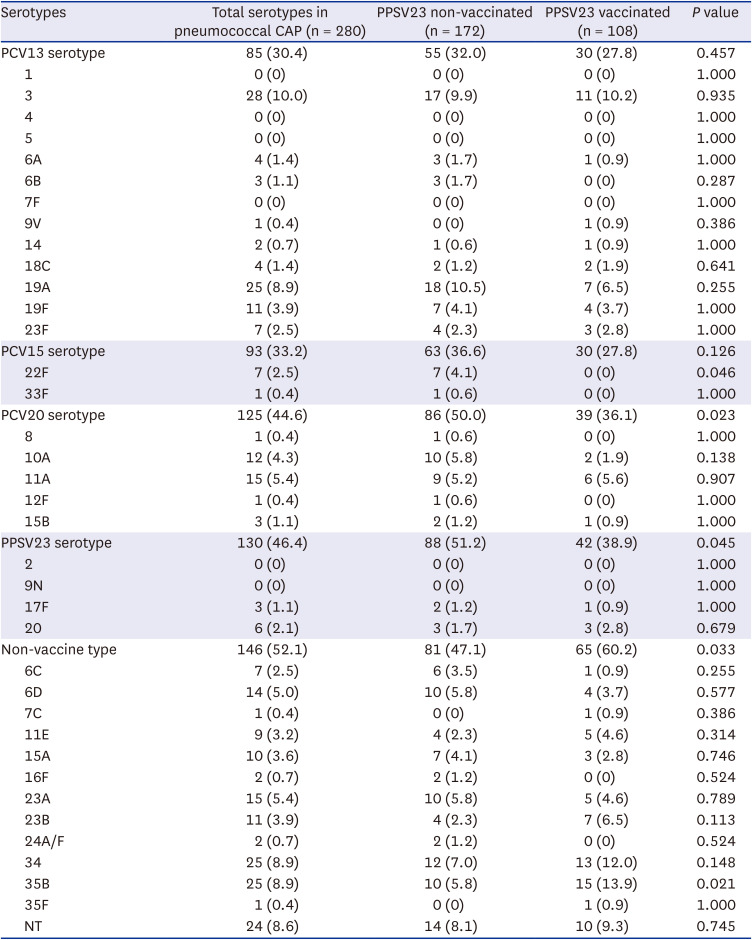
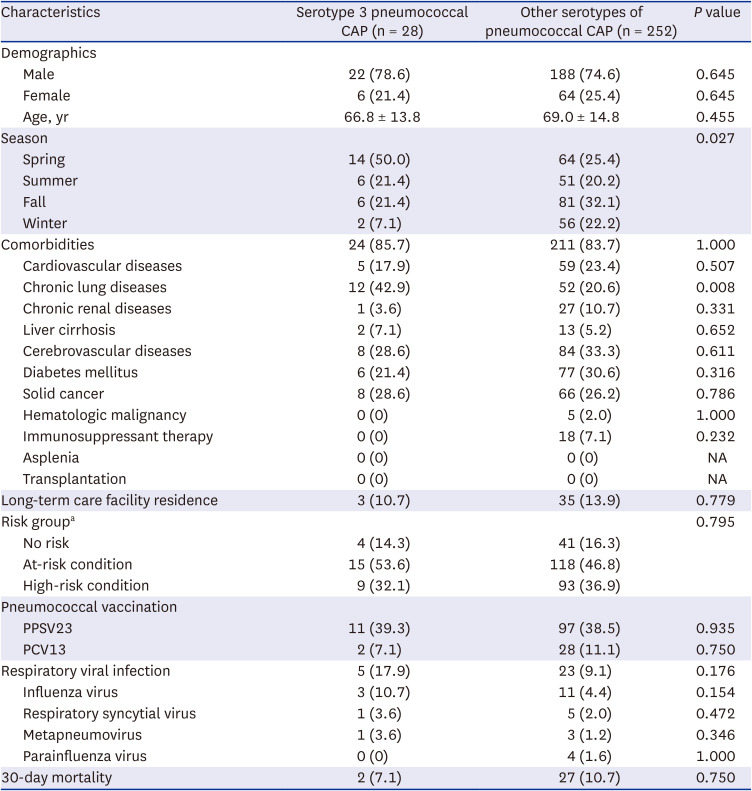
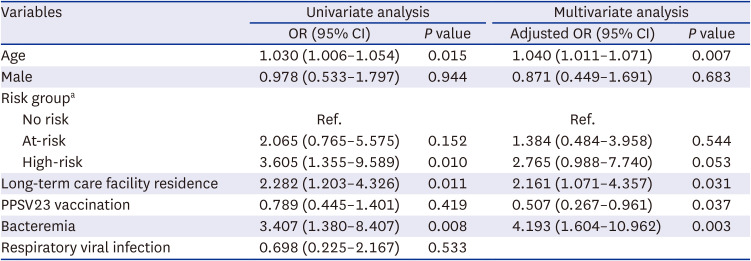




 PDF
PDF Citation
Citation Print
Print



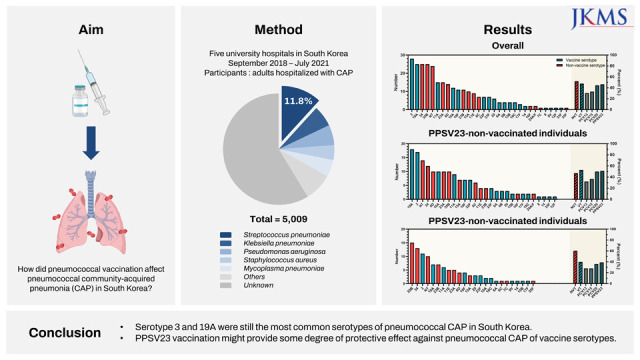
 XML Download
XML Download